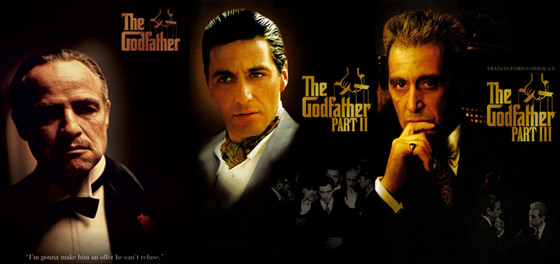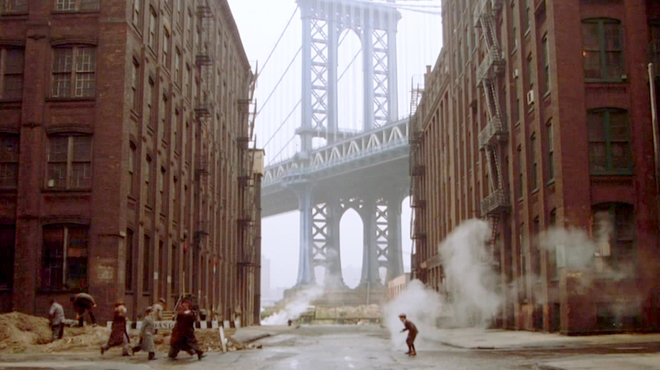3. The Godfather cannot be separated from its sequels, including the lacklustre The Godfather Part III. Once Upon a Time in America is a self-contained film.
The Godfather, wonderful though it is as a film, has endured as a favourite in the eyes of the public in no small part to the success of its sequel, The Godfather Part II. Were it not for this follow up, the original may be held in estimation comparable with that of the two Best Picture winners on either side of its release: William Friedkin’s The French Connection and George Roy Hill’s The Sting.
Both The French Connection and The Sting are fine films (Friedkin’s especially so), but neither is likely to top a poll of audiences’ favourites.
The Godfather Part II is, by all accounts, a superior film to the first. Whereas the first was a thrilling mobster tale with superb ensembles performances and gorgeous costume and set design, the sequel was a more personal story, which was less about horses’ heads being left in the bedrooms of movie moguls, and more about the United States as a haven for poverty-stricken immigrants.
It begins, not in America, but in Sicily, where a young Vito has had his whole family murdered by the local mafia crime boss. He escapes to New York, and slowly works his way to a position of considerable power (played by Robert De Niro), but not without spilling some blood along the way.
While we see this, we see Vito’s son Michael (Al Pacino) transform ‘the business’ into a soulless, destructive corporate enterprise, which eventually engulfs and incinerates family members, such as his inept brother Fredo (John Cazale).
The Godfather Part II was the first sequel to win the Best Picture Oscar, though Coppola was initially reluctant to make the film before being given complete artistic control by the head of Gulf and Western, Charles Bluhdorn. Eventually, Coppola would admit, “The way I personally feel about it now is that if The Godfather Part II hadn’t been made, there would only have been a half a movie”.
But The Godfather and The Godfather Part II cannot be accepted as two-halves of one movie. If they could, they would certainly be a strong contender for the greatest American film of the second-half of the twentieth century.
Indeed, Sight & Sound, the British Film Institute’s monthly magazine recognised both films as one work when they were placed jointly as the fourth greatest film ever made in 2002, as voted by film critics around the world. When the BFI rectified this in 2012, and votes for both were assessed separately, The Godfather came twenty-second and The Godfather Part II twenty-third.
But neither film can be seen as ‘half a movie’, because Coppola choose to direct The Godfather Part III in 1990. For years, The Godfather was unavailable to own on home video without its two predecessors. When Paramount released the film in a deluxe DVD box set replete with extra features in 2001, it was of The Godfather Trilogy. That is how the films have come to be known.
And the unavoidable fact is that The Godfather Part III reduces the average value of the trilogy considerably. It is a sloppily-written, sometimes incoherent film, which takes one of the great characters of American fiction – Michael Corleone – and changes him unrecognisably.
At the end of The Godfather Part II, Michael was a hollow figure, fractured by having ordered the death of his only surviving brother. In The Godfather Part III, minutes into the film, he’s cracking jokes about Tony Bennett records.
Once Upon a Time in America, though it may not be as iconic a film as The Godfather, at least did not partially sour its legacy with a misguided, cash-driven follow up.
4. The Godfather was a Hollywood blockbuster which earned more than any film had before. Once Upon a Time in America was butchered by its studio and buried for years.
The term ‘film maudit’, literally translated as ‘cursed movie’, has its origins in a festival held in Biarritz, France in 1949 as a riposte to Cannes. The “Festival du Film Maudit”, curated by André Bazin, among others, featured works such as Orson Welles’ The Magnificent Ambersons, notoriously mutilated by RKO and left without 43 minutes of footage, which is now deemed lost.
The term ‘film maudit’ has come to refer to any film which is unfairly maligned or neglected upon its release. If ever a work earned the term in the United States, it was Once Upon a Time in America.
The 227 version, which debuted at the Cannes Film Festival in 1984, was reduced to 139 minutes by Zach Staenberg, whose only other credits as editor were the thriller China Lake and comedy Police Academy. Stateside critics mauled the film, and after a paltry five million dollars earned from a thirty million dollar budget, it was withdrawn from theatres.
The original survived in Leone’s native Europe, but it took years before the bitter taste left by the thoughtlessly re-edited version was cleansed in the country in which the film was set. Even since, Leone’s family have attempted to beef up the 227 version by restoring scenes Leone cut to get to that still-extraordinary length.
The wisdom of doing is questionable: the 26 minutes of footage have deteriorated in quality, and stand out like a sore thumb against the original film. Leone himself, in 1988, said “let’s be honest… the version that I prefer is this one [the 227 minute version], that bit of reclusiveness is just what I like about it.”
Coppola, too, had cause to re-edit The Godfather films on occasion, though none were ever taken away from him and altered without his consent. After the success of the first film, the studio would have been crazy to interfere with Coppola’s vision. The Godfather opened nationally on 29th March 1972.
By 14th April, it was grossing over a million dollars a day, and at a time when audiences were increasingly deserting cinemas for television sets. As Box Office magazine wrote, the film “should prove that the movie audience is not ‘lost’ – but waiting to be thoroughly sold on the kind of pictures it wants to see”. Adjusted for inflation, The Godfather would go on to gross $655 million domestically, more than Joss Whedon’s The Avengers or Christopher Nolan’s The Dark Knight.
Though this demonstrates a greater appreciation among Seventies audiences for adult cinematic fare, it also demonstrates that The Godfather was, in many ways, a forerunner to the likes of Ang Lee’s Life of Pi or Ron Howard’s The Da Vinci Code; a cinematic adaptation of a best-selling novel the status of which guaranteed an inbuilt audience and thus a lucrative return on investment.
‘Populist’ is too often a pejorative descriptor when it comes to the arts, but that is precisely what The Godfather represents. Once Upon a Time in America is too hard-edged, too downbeat and too ambiguous to have ever been considered populist.
5. The Godfather brand has been used to sell everything from video games to balsamic vinegar. Once Upon a Time in America has not been used to market anything other than itself.
When Joe Mantegna announced that he had been cast as gangster Joey Zasa in The Godfather Part III, a friend reportedly replied “Wow. You’re going to be in the Italian Star Wars!”. That pithy comparison gives some insight into how beloved the characters and stories of The Godfather series have become in the hearts and minds of audiences. But it also raises another issue.
George Lucas famously declined to renegotiate his $150,000 fee for writing and directing Star Wars, instead maintaining the rights to licensing and merchandise. As a result, Lucas made hundreds of millions of dollars, selling toys, novelisations, board games, animated spin-offs and almost every other conceivable product baring the Star Wars trademark.
The original Star Wars trilogy will always be seen as the franchise which started all franchises. But it would be disingenuous to say the effect of the films has not been in some way blunted by overexposure. If you truly want to keep abreast of the Star Wars universe, you not only need to see the original three films – Star Wars, The Empire Strikes Back and Return of the Jedi. You also need to see the three prequels.
Then there’s the spin off film The Clone Wars, and its television series counterpart. You also have the animated Lego tie-ins. And for true completists, there are over 300 novels, novellas and short story collections to sink your teeth into!
The world of The Godfather is not nearly as saturated as that of Star Wars. Nonetheless, dollar signs have been a major motivational factor behind every decision made on both the films and the books. Charles Bluhdorn, attempting to coax Coppola into a second film after the success of the first, lamented “You’ve got the recipe of Coca-Cola, and you don’t wanna make any more bottles!”.
This mentality led not only to the disappointing The Godfather Part III, but to literary sequels The Godfather Returns and The Godfather’s Revenge, written by Mark Winegardner, and The Family Corleone, by Ed Falco. It led to three separate video games. In fact, The Godfather® has been used to sell everything from board games to balsamic vinegar.
It is unconceivable that anyone ever could or would turn Once Upon a Time in America into such a cash cow. We’re never likely to see a version of Monopoly where you can purchase the limousine in which Noodles raped Deborah.
Once Upon a Time in America is regarded by cineastes as one of the greatest films ever made, not because it is the most quoted. Not because its characters are loveable rogues. Not because it led to a series of standalone adventures. It is regarded as such on strength of its vision alone, and for that reason and the reasons given here, it is ultimately a greater film than The Godfather.
Author Bio: Padraic Coffey is a freelance writer and film critic who divides his time between Dublin, Ireland and Vancouver, Canada. He has written for The Sunday Independent, Ireland’s largest circulation newspaper, and Trinity College, Dublin, ranked 71st best university in world by the QS World University Rankings in 2014. Additionally, his film criticism has appeared on Volta, Ireland’s first VOD website, as well as sites such as Film Jam and Head Stuff.

